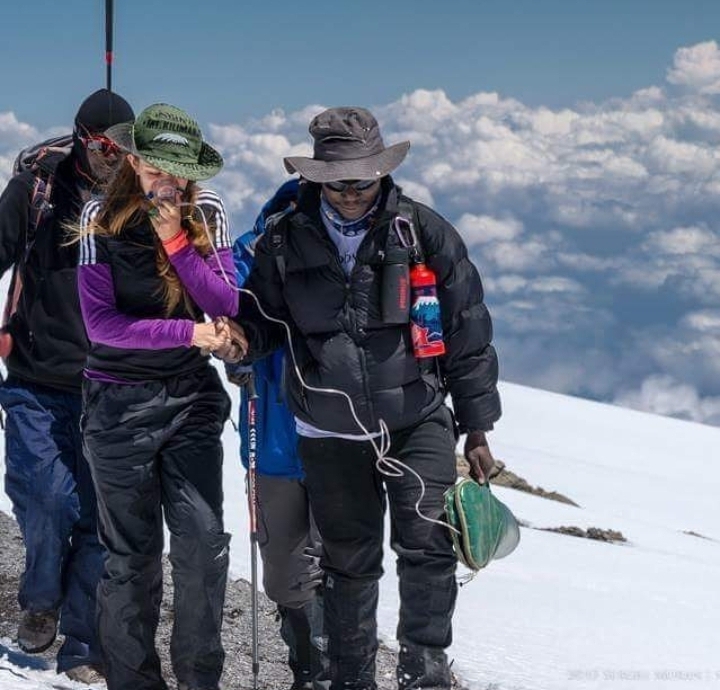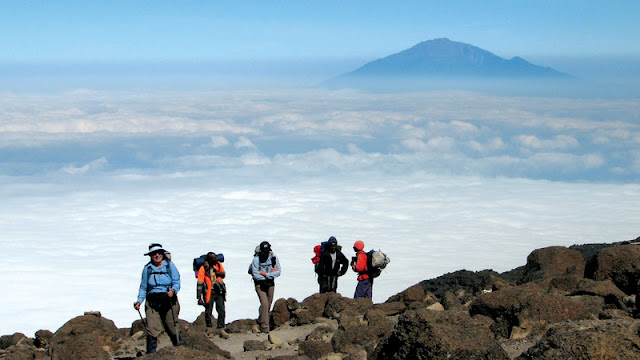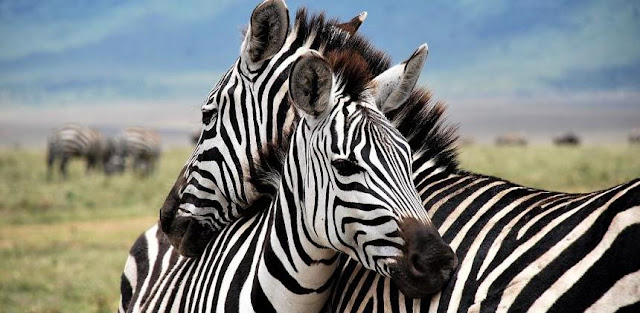KILIMANJARO SAFE TREKS
SAFE TREKKING
Altitude sickness on Kilimanjaro and other health problems
Acute mountain sickness, more commonly known as altitude sickness, is the single biggest killer on Kilimanjaro. This may surprise a few people who, given the large number of trekkers who climb Kilimanjaro each year, are under the mistaken impression that Africa’s highest mountain is also a safe mountain. Unfortunately, as any mountaineer will tell you, there’s no such thing as a safe mountain, particularly one nearly 6000m tall with extremes of climate near the summit and ferociously carnivorous animals roaming the lower slopes.Your biggest enemy on Kilimanjaro, however, is likely to be neither the weather nor the wildlife but the altitude. Unsurprisingly, KINAPA are shy about revealing how many trekkers perish on Kili each year but what is known is that, during the millennium celebrations, when the mountain was swamped by more than a thousand trekkers on New Year’s Eve alone, three died and thirty-three more had to be rescued.The authorities are doing what they can to minimize the number of deaths: guides are given thorough training in what to do if one of their group is showing signs of altitude sickness and trekkers are required to register each night upon arrival at the campsite and have to pay a US$20 ‘rescue fee’ as part of their park fees.But you too can do your bit, by avoiding AMS in the first place. The pages in this section discuss in detail what AMS actually is, how it is caused, the symptoms and, finally, how to avoid it. Read this section carefully: it may well save your life
What is Altitude Sickness or AMS?
The science of altitude sickness
The science behind altitude sickness is fairly simple to follow. Throughout the troposphere (ie from sea level to an altitude of approximately 10km), the air composition is in fact always the same, namely 20% oxygen and nearly 80% nitrogen.So when you read that there is a lack of oxygen at the summit, that’s not strictly true – oxygen still makes up 20% of the air. So the problem is not lack of oxygen – but the lack of air pressure.To put it in more precise terms: atmospheric pressure drops by about tenth for every 1000m of altitude. Thus the air pressure at the top of Kilimanjaro is approximately 40% of that found at sea level.In other words, and to put it in layman’s terms, though each breath inhaled at the summit is 20% oxygen, just as it is at sea level, it becomes much harder to fill your lungs since the atmosphere is not pushing so much air into them. As a result, every time you breathe on Kibo you take in only about half as much air, and thus oxygen, as you would if you took the same breath in Dar es Salaam.
Oxygen and us: the truth
This can, of course, be seriously detrimental to your health; oxygen is, after all, pretty essential to your physical well-being. All of your vital organs need it, as do your muscles. They receive their oxygen via red blood cells, which are loaded with oxygen by your lungs and then pumped around your body by your heart, delivering oxygen as they go. Problems arise at altitude when that most vital of organs, the brain, isn’t getting enough oxygen and malfunctions as a result; because as the body’s central control room, if the brain malfunctions, so does the rest of you, often with fatal consequences.
So how does a lack of oxygen lead to altitude sickness?
Fortunately, your body is an adaptable piece of machinery and can adjust to the lower levels of oxygen that you breathe in at altitude. Unconsciously you will start to breathe deeper and faster, your blood will thicken as your body produces more red blood cells, and your heart will beat faster. As a result, your essential organs will receive the same level of oxygen as they always did.But your body needs time before it can effect all these changes. Though the deeper, faster breathing and heart-quickening happen almost as soon as your body realizes that there is less oxygen available, it takes a few days for the blood to thicken. And with Kilimanjaro, of course, a few days is usually all you have on the mountain, and the changes may simply not happen in time. The result, is AMS.AMS, or acute mountain sickness (also known as altitude sickness), is what happens when the body fails to adapt in time to the lack of air pressure at altitude. There are three levels of AMS: mild altitude sickness, moderate altitude sickness and severe altitude sickness. On Kilimanjaro, it’s fair to say that most people will get some symptoms of the illness and will fall into the mild-to-moderate categories.Having symptoms of mild AMS is not necessarily a sign that the sufferer should give up climbing Kili and descend immediately. Indeed, most or all of the symptoms suffered by those with mild AMS will disappear if the person rests and ascends no further, and assuming the recovery is complete, the assault on the summit can continue.The same goes for moderate AMS too, though here the poor individual and his or her symptoms should be monitored far more closely to ensure that they are not getting any worse and developing into severe AMS. This is a lot more serious and sufferers with severe AMS should always descend immediately, even if it means going down by torchlight in the middle of the night.
Symptoms of Altitude Sickness
Mild altitude sickness (mild AMS)
The symptoms of mild AMS are not dissimilar to the symptoms of a particularly vicious hangover, namely a thumping headache, nausea and a general feeling of lousiness. An AMS headache is generally agreed to be one of the most dreadful headaches you can get, a blinding pain that thuds continuously at ever decreasing intervals; only those who have bungee-jumped from a 99ft building with a 100ft elasticated rope will know the intense, repetitive pain AMS can cause.Thankfully, the usual headache remedies should prove effective against a mild AMS headache. As with a hangover, mild AMS sufferers often have trouble sleeping and, when they do, that sleep can be light and intermittent. They can also suffer from a lack of appetite. Given the energy you’ve expended getting to altitude in the first place, both of these symptoms can seem surprising if you’re not aware of AMS.
Moderate altitude sickness (moderate AMS)
Moderate AMS is more serious and requires careful monitoring of the sufferer to ensure that it does not progress to severe AMS. With moderate AMS, the sufferer’s nausea will lead to vomiting, the headache will not go away even after pain-relief remedies, and in addition the sufferer will appear to be permanently out of breath, even when doing nothing.With moderate AMS, it is possible to continue to the summit, but only after a prolonged period of relaxation that will enable the sufferer to make a complete recovery. Unfortunately, treks run to tight schedules and cannot change their itineraries mid-trek. Whether you, as a victim of moderate AMS, will be given time to recover will depend largely upon how fortunate you are, and whether the onset of your illness happens to coincide with a scheduled rest day or not.
Severe altitude sickness (severe AMS)
With severe AMS, on the other hand, there should be no debate about whether or not to continue: if anybody is showing symptoms of severe altitude sickness it is imperative that they descend immediately. These symptoms include a lack of coordination and balance, a symptom known as ataxia.A quick and easy way to check for ataxia is to draw a 10m line in the sand and ask the person to walk along it. If they clearly struggle to complete this simple test, suspect ataxia and descend. (Note, however, that ataxia can also be caused by hypothermia or extreme fatigue. As such, ensure that the sufferer is suitably dressed in warm clothing and has eaten well before ascertaining whether or not he or she is suffering from ataxia, and what to do about it).
Other symptoms of severe AMS
Other symptoms of severe altitude sickness include mental confusion, slurred or incoherent speech, and an inability to stay awake. There may also be a gurgling, liquid sound in the lungs combined with a persistent watery cough which may produce a clear liquid, a pinky phlegm or possibly even blood. There may also be a marked blueness around the face and lips, and a heartbeat that, even at rest, may be over 130 beats per minute. These are the symptoms of either HACO and HAPO, as outlined in the next section
HACO (HACE) and HAPO (HAPE)
Poor Mapandi, a carrier whom I had noticed shivering with fever for the last day or two, stiffened, grew cold and died beside me in the mud. Peter MacQueen in his book In Wildest Africa
High Altitude Cerebral Oedema / Edema (HACO /HACE)
HACO (HACE in American English, where the spelling is ‘edema’) of is a build-up of fluid around the brain. It’s as serious as it sounds. It is HACO that is causing the persistent headache, vomiting, ataxia and the lack of consciousness. If not treated, death could follow in as little as 24 hours, less if the victim continues ascending.
High Altitude Pulmonary Oedema / Edema (HAPO / HAPE)
Just as serious, HAPO (HAPE in American English) is the accumulation of fluid around the lungs. It is this condition that is causing the persistent cough and pinkish phlegm. Once again, the only sensible option is to descend as fast as possible. In addition, one of the treatments outlined on p000 in the guide should also be considered
How to avoid altitude sickness on Kilimanjaro
Acclimatizing for Kilimanjaro
Altitude sickness is avoidable. The only surefire way to to do is to take your time climbing Kilimanjaro. Opting to save money by climbing the mountain as quickly as possible is a false economy: the chances are you will have to turn back because of altitude sickness and all your efforts (and money) will be wasted. According to the Expedition Advisory Committee at the Royal Geographical Society, the recommended acclimatization period for any altitude greater than 2500m is to sleep no more than 300m higher than your previous night’s camp, and to spend an extra night at every third camp.But if you were to follow this on the Kilimanjaro’s Marangu Route, for example, from Mandara Huts you would have to take a further eight nights in order to safely adjust to the Kibo Huts’ altitude of 4700m – whereas most trekkers take just two days to walk between the two.
Tactics for avoiding altitude sickness on Kilimanjaro
Take a pre-acclimatization climb before tackling Kilimanjaro
The EAC realize that the short distances and high per diem cost of climbing Kilimanjaro make this lengthy itinerary impractical, so instead they recommend a pre-trek acclimatization walk on Mount Meru or Mount Kenya (4895m to Point Lenana).>This is an excellent idea if you have the time and are feeling fit, and providing you do one of these walks immediately before you climb Kili, these treks can be beneficial – and the views towards Kilimanjaro from Meru are delightful too.
Take rest days on Kilimanjaro
But what if you don’t have the time or money to do these other climbs? The answer is to plan your walk on Kilimanjaro as carefully as possible. If you have enough money for a ‘rest day’ or two, take them.These ‘rest days’ are not actually days of rest at all – on the Marangu trail, for example, guides usually lead their trekkers up from Horombo Huts to the Mawenzi Hut at 4600m before returning that same afternoon. But they do provide trekkers with the chance to experience a higher altitude before returning to below 3000-4000m again, thereby obeying the mountaineers’ old maxim about the need to ‘climb high, sleep low’ to avoid mountain sickness.
Choose a ’slow’ route up Kilimanjaro
The route you take is also important. Some of the routes – the Machame, Lemosho and Shira trails via the Barafu Huts, for example – obey the mountaineers’ maxim on the third or fourth days, when the trail climbs above 4500m before plunging down to an altitude of 3985m at Barranco Camp where you spend the night.Some of the shorter trails, however, do not: for example, it is possible for a trekker walking at an average pace on the Marangu or Rongai trails to reach the Kibo Huts in three days and attempt an assault on the summit for that third night. This sort of schedule is entirely too rapid, allowing insufficient time for trekkers to adapt to the new conditions prevalent at the higher altitude.This is why the majority of people fail on these trails and it is also the reason why, particularly on these shorter trails, that it is imperative that you take a ‘rest day’ on the way up: to give your body more time to acclimatize.
Walk as slowly as possible on Kilimanjaro — go ‘pole pole’ if you don’t want to feel ‘poorly poorly’
How you approach the walk is important too. Statistically, men are more likely to suffer from AMS than women, with young men the most vulnerable. The reason is obvious. The competitive streak in most young men causes them to walk faster than the group; that, and the mistaken belief that greater fitness and strength (which most men, mistakenly or otherwise, believe they have) will protect them against AMS. But AMS is no respecter of fitness or health.Indeed, many experienced mountaineers believe the reverse is true: the less fit you are, the slower you will want to walk, and thus the greater chance you have of acclimatizing properly.The best advice, then, is to go as slowly as possible. Let your guide be the pacemaker: do not be tempted to hare off ahead of him, but stick with him. That way you can keep a sensible pace – and, what’s more, can ask him any questions about the mountain that occur to you on the way.The most frequently heard phrase on Kilimanjaro is ‘Pole pole’. It means ’slowly slowly’, and it should be your mantra for your trek.
Take Diamox
In addition to being a cure for altitude sickness, Diamox can also act as a prophylactic – ie, it can prevent the onset of altitude sickness happening in the first place. There seems to be no hard-and-fast rule about how much you should take each day, and when you should start, but most companies seem to advise taking 125mg twice a day, starting on the first day of the trek.
Other tips for avoiding altitiude sickness on Kilimanjaro
There are other things you can do that may or may not reduce the chance of getting AMS. One is to eat well: fatigue is said to be a major contributor to AMS, so try to keep energy levels up by eating as much as you can.Dehydration can exacerbate AMS too, so it is vital that you drink every few minutes when walking; for this reason, one of the new platypus-style water bags which allow you to drink hands-free without breaking stride are invaluable. Wearing warm clothes is very important too, allowing you to conserve energy that would otherwise be spent on maintaining a reasonable body temperature.Although there hasn’t been a serious study on this subject, many people swear that carrying your own rucksack increases your chance of succumbing to AMS. Certainly, in my experience, this is true, so, finally, hire a porter to carry your baggage (the agencies will assume you want this anyway unless you specify otherwise).




Comments